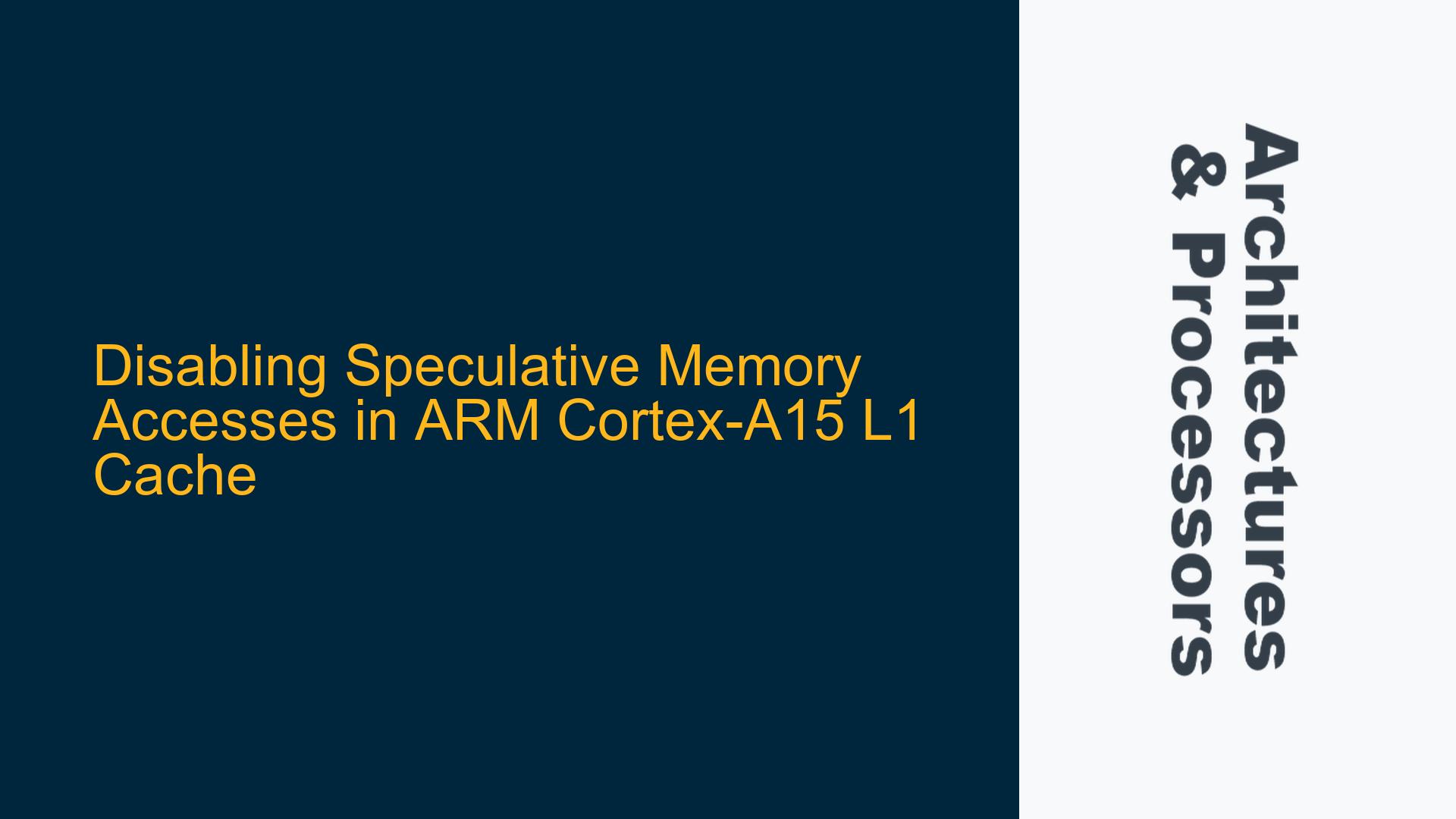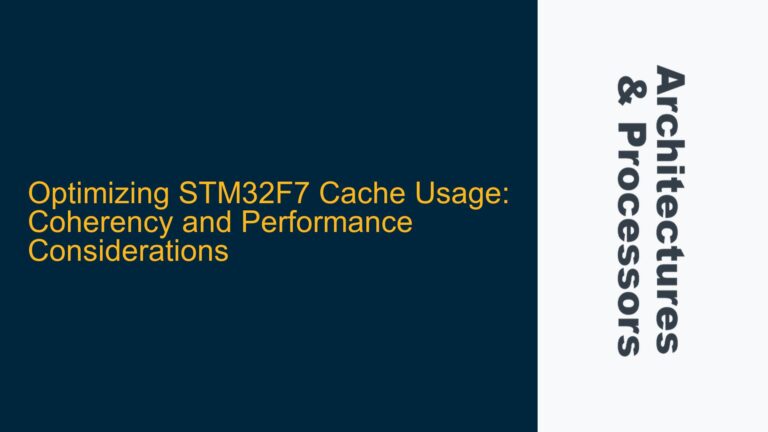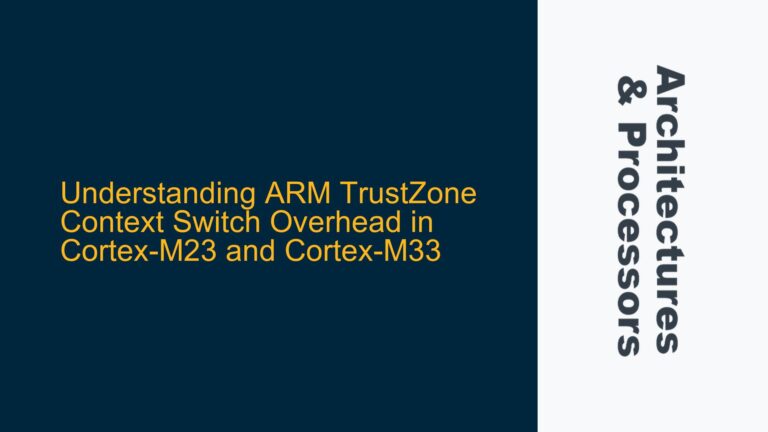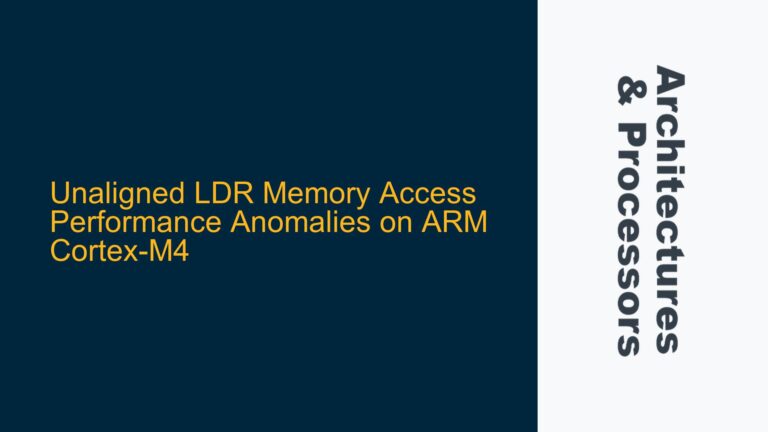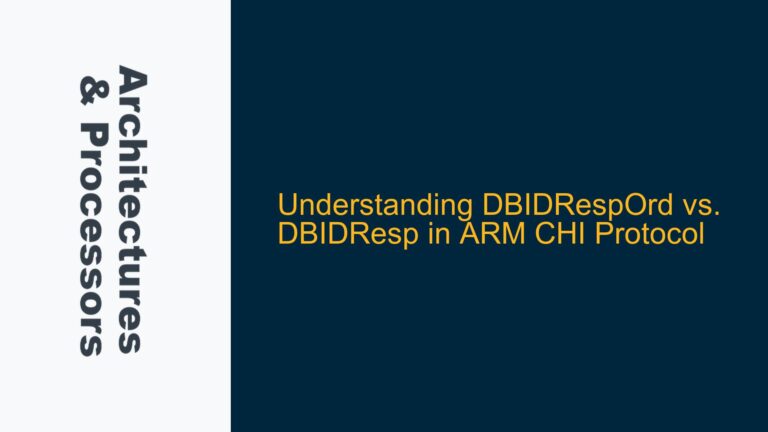ARM Cortex-A15 Speculative Memory Access Issues and Performance Trade-offs
The ARM Cortex-A15 processor, known for its high performance and efficiency, incorporates speculative memory accesses as part of its optimization strategy. Speculative memory accesses allow the processor to pre-fetch instructions and data before they are explicitly needed, reducing latency and improving overall performance. However, this feature can lead to unintended side effects, particularly when the processor speculatively accesses memory regions that are forbidden or invalid. This can result in unpredictable behavior, such as accessing restricted memory addresses, which may compromise system stability or security.
In the context of the Cortex-A15 (revision r2p2), disabling speculative memory accesses has been proposed as a solution to prevent such unauthorized memory accesses. However, this approach comes with significant performance penalties, potentially slowing down processing speeds by up to 50%. This trade-off necessitates a careful evaluation of the system requirements and the specific use case to determine whether the performance degradation is acceptable in exchange for increased stability and security.
The primary concern revolves around the interaction between speculative memory accesses and branch prediction mechanisms. When speculative accesses are enabled, the processor may attempt to fetch instructions from memory regions that are not intended to be executable, leading to random access violations. This behavior is particularly problematic in systems where memory protection and security are critical, such as in embedded systems or real-time applications.
To address this issue, it is essential to understand the underlying mechanisms of speculative memory accesses and the available control mechanisms provided by the ARM architecture. The ARMv7-A architecture, which the Cortex-A15 implements, offers several ways to manage speculative accesses, including the use of the Execute Never (XN) bit in the Memory Management Unit (MMU) page tables. By setting the XN bit for specific memory regions, the processor can be prevented from speculatively fetching instructions from those regions, thereby mitigating the risk of unauthorized accesses.
However, implementing these controls requires a deep understanding of the ARM architecture and the specific implementation details of the Cortex-A15 processor. The following sections will explore the possible causes of speculative memory access issues, the architectural controls available to manage these accesses, and the steps required to implement these controls effectively.
Memory Protection and Speculative Access Control Mechanisms in ARMv7-A
The ARMv7-A architecture provides several mechanisms to control speculative memory accesses and enforce memory protection. These mechanisms are implemented through the System Control Register (SCTLR) and the Memory Management Unit (MMU). The SCTLR contains bits that control the behavior of the instruction cache, data cache, and speculative accesses, while the MMU allows for fine-grained control over memory regions through page tables.
One of the key bits in the SCTLR is the I bit, which controls the behavior of the instruction cache. When the I bit is set to 0, the instruction cache is disabled, which also has the side effect of disabling speculative instruction fetches. However, this approach is not ideal, as it disables both the instruction cache and speculative accesses, leading to a significant performance degradation. A more targeted approach is to use the XN bit in the MMU page tables to prevent speculative instruction fetches from specific memory regions without disabling the instruction cache entirely.
The XN bit, when set to 1, marks a memory region as non-executable, preventing the processor from fetching instructions from that region. This is particularly useful for marking memory regions that should not be executed, such as device memory or memory-mapped I/O regions. By setting the XN bit for these regions, the processor can be prevented from speculatively fetching instructions from them, thereby avoiding potential access violations.
In addition to the XN bit, the ARMv7-A architecture also provides other memory protection mechanisms, such as the use of memory barriers and cache management instructions. Memory barriers can be used to enforce ordering constraints on memory accesses, ensuring that speculative accesses do not violate the intended memory access sequence. Cache management instructions, such as cache invalidate and clean operations, can be used to ensure that the cache contents are consistent with the memory contents, preventing speculative accesses from using stale or invalid data.
The Cortex-A15 processor also provides implementation-defined controls that allow for further fine-tuning of speculative access behavior. These controls are documented in the Cortex-A15 Technical Reference Manual (TRM) and can be used to adjust the behavior of the prefetcher, branch predictor, and other components that influence speculative accesses. However, these controls are highly implementation-specific and should be used with caution, as they can have unintended side effects on system performance and behavior.
Implementing XN Bit in MMU Page Tables for Cortex-A15
To effectively manage speculative memory accesses in the Cortex-A15 processor, it is essential to understand how to configure the MMU page tables to set the XN bit for specific memory regions. The ARMv7-A architecture supports two types of page table formats: the Short-descriptor format and the Long-descriptor format. Both formats allow for the setting of the XN bit, but they differ in their structure and the level of granularity they provide.
The Short-descriptor format is the more commonly used format and supports two levels of page tables: the first-level table (L1) and the second-level table (L2). The L1 table contains entries that either point to L2 tables or directly describe 1MB sections of memory. The L2 table contains entries that describe 4KB or 64KB pages. The XN bit is located in the second-level descriptor and can be set to 1 to mark a 4KB or 64KB page as non-executable.
The Long-descriptor format, on the other hand, supports three levels of page tables: the first-level table (L1), the second-level table (L2), and the third-level table (L3). The L1 and L2 tables contain entries that point to the next level of tables, while the L3 table contains entries that describe 4KB pages. The XN bit is located in the third-level descriptor and can be set to 1 to mark a 4KB page as non-executable.
For systems that require fine-grained control over memory regions, the Long-descriptor format is often preferred, as it allows for the setting of the XN bit on a per-4KB page basis. This level of granularity is particularly useful in systems where memory protection and security are critical, as it allows for precise control over which memory regions are executable and which are not.
To implement the XN bit in the MMU page tables, the following steps should be taken:
-
Determine the Memory Regions to Protect: Identify the memory regions that should be marked as non-executable. This typically includes device memory, memory-mapped I/O regions, and any other regions that should not be executed.
-
Configure the MMU Page Tables: Depending on the page table format being used (Short-descriptor or Long-descriptor), configure the appropriate level of page tables to set the XN bit for the identified memory regions. For the Short-descriptor format, this involves setting the XN bit in the second-level descriptor for 4KB or 64KB pages. For the Long-descriptor format, this involves setting the XN bit in the third-level descriptor for 4KB pages.
-
Enable the MMU: Once the page tables have been configured, enable the MMU to enforce the memory protection settings. This typically involves setting the appropriate bits in the SCTLR to enable the MMU and the instruction cache.
-
Verify the Configuration: After enabling the MMU, verify that the XN bit has been correctly set for the intended memory regions. This can be done by attempting to execute code from the protected regions and ensuring that the processor generates an exception or fault.
-
Optimize for Performance: While the XN bit provides a way to prevent speculative accesses to non-executable memory regions, it is important to consider the performance impact of these settings. In some cases, it may be necessary to adjust the cache configuration or use memory barriers to ensure that the system performance is not adversely affected.
By following these steps, it is possible to effectively manage speculative memory accesses in the Cortex-A15 processor and prevent unauthorized memory accesses while minimizing the impact on system performance. The use of the XN bit in the MMU page tables provides a powerful tool for enforcing memory protection and ensuring system stability and security.
